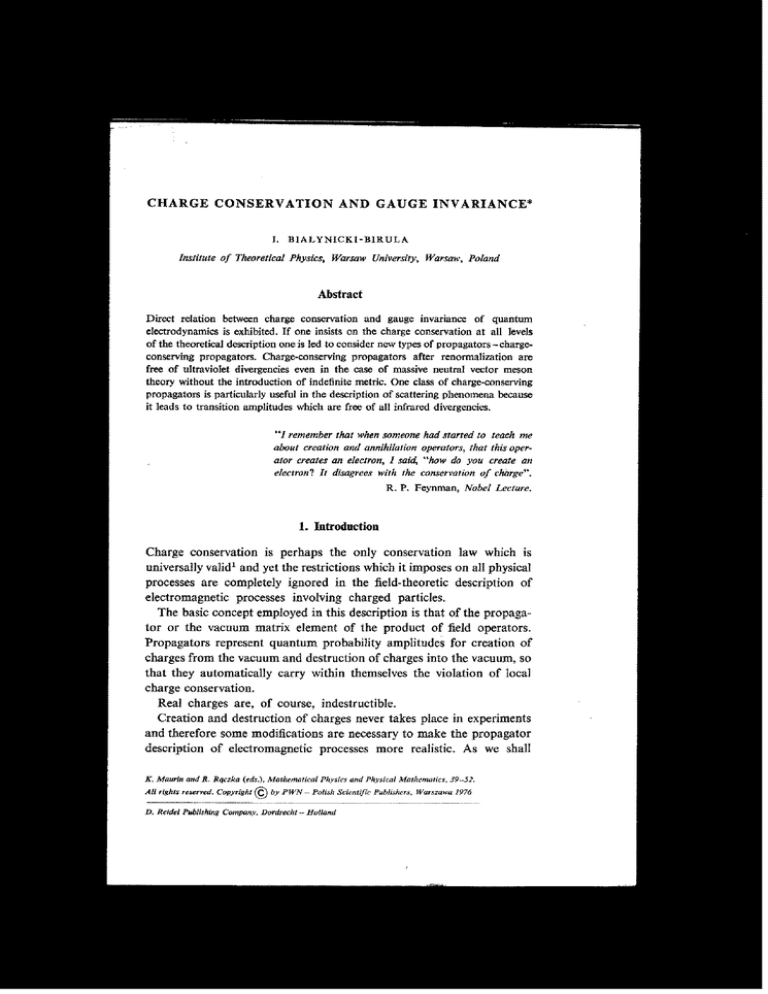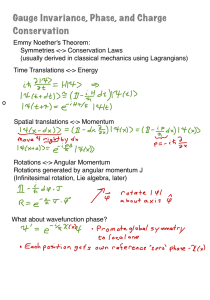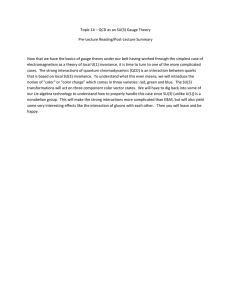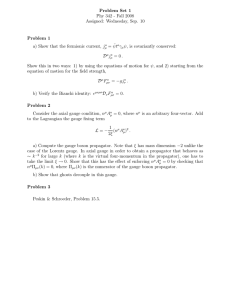
CHARGE CONSERVATION
I.
AND GAUGE INVARIANCE*
BIALYNICKI-BIRULA
Institute of Theoretical Physics, Warsaw University, Warsaw, Poland
Abstract
Direct relation between charge conservation and gauge invariance of quantum
electrodynamics is exhibited. If one insists on the charge conservation at all levels
of the theoretical description one is led to consider new types of propagators - chargeconserving propagators. Charge-conserving propagators after renormalization are
free of ultraviolet divergencies even in the case of massive neutral vector meson
theory without the introduction of indefinite metric. One class of charge-conserving
propagators is particularly useful in the description of scattering phenomena because
it leads to transition amplitudes which are free of all infrared divergencies.
"I remember that when someone had started to teach me
about creation and annihilation operators, that this operator creates an electron, I said, "how do you create an
electron? It disagrees with the conservation of charge".
R. P. Feynman, Nobel Lecture.
1. Introduction
Charge conservation is perhaps the only conservation law which is
universallyvalid! and yet the restrictions which it imposes on all physical
processes are completely ignored in the field-theoretic description of
electromagnetic processes involving charged particles.
The basic concept employed in this description is that of the propagator or the vacuum matrix element of the product of field operators.
Propagators represent quantum probability amplitudes for creation of
charges from the vacuum and destruction of charges into the vacuum, so
that they automatically carry within themselves the violation of local
charge conservation.
Real charges are, of course, indestructible.
Creation and destruction of charges never takes place in experiments
and therefore some modifications are necessary to make the propagator
description of electromagnetic processes more realistic. As we shall
K. Maurin and R. Rqczka (eds.), Mathematical
All rights reserved. Copyright
© by PWN
Physics and Physical Mathematics,
39-52.
- Polish Scientific Publishers, Warszawa 1976
D. Reidel Publishing Company, Dordrecht - Holland
40
CHARGE
I. BIALYNICKI-BIRULA
see later, these modifications lead to a theory which is also formally
more appealing. Abstraction and simplifications must always be introduced, it is true, in a theoretical description of every real process, but
these should not be made at the expense of the fundamental laws of
nature.
The compliance with the requirements of local charge conservation
leads to a highly welcome property of the formalism, namely, gauge
invariance becomes manifest at all levels of the theoretical description.
In order to account for the charge conservation in the description
of all processes one must take into consideration the additional currents
that flow during every experiment in which beams of charged particles
are produced. These additional currents flow between the source and the
detector of charged particles and we will call them the compensating
currents because they compensate for the charge lost by the source and
gained by the detector. Taking into account the compensating currents,
instead of creation and destruction one simply has the separation and the
recombination of charges.
The idea of compensating currents is in full accord with the observation that the natural state of all matter (at least under terrestial conditions)
is an electrically neutral state.
The form of the compensating current win, of course, depend on the
conditions of the experiment, but we expect this form to have only a
negligible influence on the results of the experiment, provided these currents flow far from the region in which the interaction of particles occurs.
Compensating currents can be described at various levels of sophistication, ranging from classical mechanics to quantum field theory. In this
paper we shall adopt the simplest approach assuming that all dynamical
aspects of the compensating current can be neglected so that the current
can be described by a set of four given c-number functions JlJ,(z) of
space-time coordinates. Such an external current can be considered
to be a part of the apparatus used for the initial preparation and the
final measurement of the quantum system. Even this greatly simplified
model is quite sufficient to produce renormalizability of neutral vector
meson theory in the physical Hilbert space and the disappearance of all
infrared divergencies.
In what follows we shall restrict ourselves, for definiteness, to the
study of electrons interacting with the electromagnetic field (pure
CONSERVATION
AND GAUGE
INVARIANCE
41
quantum electrodynamics), but our method can be applied equally
well to the description of processes involving other charged particles.
Many of the ideas presented in Sees. 2-4 are not new. They can be
found in Brandeis Lectures by Johnson and in the book by Schwinger
[11], [15] and also in earlier works of the present author [2], [3], [5].
We give here a unified derivation which is best suited for the discussion
of Sec. 5.
We found it more convenient to construct quantum electrodynamics,
with charge conservation built in, in two steps. In the first step (Sec. 2)
we introduce the quantized electron field operators tp(x) and v;(x) but
we treat the electromagnetic field as an external field, described by four
functions .91iz) of space-time coordinates. In the second step (Sec. 3)
we quantize the electromagnetic field with the help of a method first
introduced by Feynman, In Sec. 4 we shall prove the existence of a very
simple relationship between the new charge-conserving, gauge-invariant
propagators and the old charge-nonconserving, gauge-dependent propagators. In Sec. 5 we discuss the role of charge-conserving propagators
in the removal of ultraviolet and infrared divergencies.
2. External Electromagnetic Field
Let us consider n electrons negatons and/or positons moving in a prescribed electromagnetic field which vanishes in the remote past and in
the distant future.
The vacuum matrix element·of the time-ordered product of electron
field operators
(1)
T[XI'
... , Xn,Yn,
= (tJ°utl T(tp(xI),
""Ylld]
... , tp(xn)1j1(Yn), ... , 1j1(YI) )tJin)
has the interpretation of the probability amplitude of the process in
which negatons first are being created from the vacuum at the points
Yt, ... , Yn or positons created at the points Xl, ... , Xn and subsequently
annihilated at the points Xl, ... , x; or positons annihilated at the points
Yl, ... , Yn' The state vectors tJin and tJout describe respectively the state
which is the vacuum state in the past and in the future.
In the simplified version of the theory I1-0wunder consideration,
the vacuum matrix element (1) can be expressed ([8], [13], [14]) as a sum
t!
I
42
I. BIALYNICKI-BIRULA
CHARGE
of products of the vacuum to vacuum transition amplitude C[d] and
one-electron Feynman propagators KF[x, Yld]
(2)
T[XI' ... , X,,, y", ... , Ylld]
= (-i)"C[d]KF[XI'
.. ·,Ylld],
where
(3)
KF[XI, ... , X,,, Y", ... , Ylld]
L:
==
epKF[xt.Yitld],
... ,KF[x"'Yi"ld].
permi
The introduction of an external current changes the probability amplitude T[xl> ... , x,,, y", ... , Ylld] only by the following phase factor
(4)
exp{-i~d4zdl'(z)JI'(z)}.
The compensating current, which we want to use in formula (4), in the
case of n electrons depends not only on z but also on the coordinates Xl, ... , X" and YI, ... , y" at which electrons appear and/or disappear. We shall indicate this dependence explicitly by writing
JI'(z; Xl, ... , X",Yl, ... ,y,,). The conservation of charge requires that
the compensating current satisfies the following inhomogeneous continuity equation
(5)
GI'JI'(z; Xl, ... , X"' Yl, ... , y,,)
= e
L
(t5(4)(Z-Xi)- O(4)(Z-Yi»).
+ GA] = exp( -ieA(x»)
KF[x, yld
=
•••
,
Xn, y", ... , Ylld,
<P[x, yld]
== -e ~ d;"d,,(;),
y
represents a special case of our more general expression:
~d4zd p(z)JI'(z; X, y).
... ,xn,y",
X"l, •.. ,
Xn, Yl, ... , y,,)} X
···'Ylld].
Even though the phase factor (4) has no effect on the probabilities when
external current is not dynamically coupled to electrons, it makes the
charge conserving propagator (6) gauge invariant under gauge transformations of the vector potential of the external field
--+
dl'(z)
(11)
JIl(z; x, y)
= -e ~ d;"t5(4)(Z-;)
y
and then check that indeed J" obeys the right equation:
J]
(-i)"exp{ -i ~d4zdp(z)J:(z;
dl'(z)
KF [x, Yld]exp(ieA(y».
x
xC[d]KF[Xl,
(7)
43
In order to see this it suffices to make the following identification
The n-electron propagator in the presence of a compensating current
will be denoted by T[Xl, ... , X"' Yo, ... , Ylld, J],
T[x1,
INVARIANCE
x
(9)
i=l
(6)
GAUGE
The gauge invariance is such an appealing theoretical feature, after all,
all measurable quantities must be gauge invariant, that we believe that
the modified propagators (6) are much more suitable for the description
of real processes than ordinary propagators, which are always gauge
dependent.
The idea of introducing phase factors to construct various gaugeinvariant quantities from gauge-dependent object is an old one. It goes
back to Dirac [6], [7] and Heisenberg (10)2who were the first to realize
the importance of line integrals in the construction of physical quantities.
A line integral <P[x, yld1 of the vector-potential evaluated along
a certain trajectory in space-time,
(10)
I!""'n ,,..
AND
C[d], from eq. (5) and from the following transformation property
of KF'S under the change of gauge
(8)
... ,X",y",
CONSERVATION
+ G"A(z).
This gauge invariance of T[Xl' ... , X"' Y", ... , Ylld, J] follows from
the gauge invariance of the vacuum to vacuum transition amplitude
(12)
G"J"(z; x,y)
= e(t5(4)(z-x)_!5(4)(z-y»).
For n electrons one must introduce n trajectories. Extensive use of line
integrals was made in the gauge-invariant formulation of quantum
electrodynamics given by Mandelstam [12].
3. Quantized Electromagnetic Field
The transition from the external field case (first step) to the quantized
field case (second step) can be accomplished [9] by expanding the external field propagators into power series in external potentials, selecting
44
CHARGE
I. BIAL YNICKI-BIRULA
pairs of potential vectors in all possible ways and replacing each pair,
say dll(z) and d.(z'), by the Feynman photon propagator D:.(z-z'),
,
(13)
== -gll.DF(z-z'),
D:.(z-z')
multiplied by -i. The full n-electron propagator, with all the effects of
interaction via photon exchanges included, will be denoted by I[x 1, ..• ,
x,; Yn, ... , Ylld, J]. It can be written in the following compact form
with the use of functional derivatives
(14)
I[xl,
... ,Xn,Yn'''',Ylld,J]
= exp(~i
15)
\
J
~
~d
D
F
~
~d
shortened
D:.(z-z')
\d4 \d4 ,
= J zJ Z
-
4. Equivalence
~
F (
~dll(z)
Dil• z-
z')
~
-.-.,,,.
-+
D:.(z-z')+
°llf.(z-z')+
~
all ~diz)
0 =
Theorem
(19)
1'[Xl' ... , Xn, Yn, ... , hid,
= (-i)"exp
x exp{
X
J]
{ - i ~d4zd Il(Z)JIl(Z; Xl, ... , Xn,Yn, ... , Yl)} x
;i H~~-if)
DF( ~~
-if)}
C[d] x
KF[Xl, ... , Xn, YII' ... , Ylld].
Let us now choose the simplest solution of eq. (5) for the compensating current, namely the one which can be expressed in terms of one
vector function a"(z) of space-time coordinates
II
1'[Xl,
...
,XII,Yn, "',Ylld,J]
which follows directly from the invariance
transformations
of the potential
(18)
45
We will show in this section, that under certain natural assumptions on the
compensating current, our current-dependent
but gauge-invariant propagators become numerically equal to the gauge-dependent
but currentindependent propagators of the standard theory" evaluated in a particular gauge. To this end we shall rewrite the current-dependent
propagator (6) in the form
o.fiz'-z),
where fll(z) is any vector function of space-time coordinates."
The f-dependent
gauge terms in the photon propagator do not contribute to the charge-conserving
propagators
I[xl>""
Xn, Yn, ... , Yll
.91 , J] as seen from the equation
(17)
INVARIANCE
It thus follows that the charge-conserving
propagators
are invariant
under two types of gauge transformations:
of the external potential and
of the free photon propagator. Free photon propagator in any gauge
therefore can be used in the exponential
operation in formula (14)
leading to the same final result. The Feynman gauge, of course, is the
simplest and for that reason we have chosen it in formula (13).
It should be stressed, however, that our charge-conserving
propagators depend on the form of the compensating current. This compensating current should in principle be appropriately
chosen for each
experimental situation.
notation
We will not consider here mixed electron-photon
propagators, because
the presence of real photons has no bearing on the question of charge
conservation.
Owing to our inclusion of the compensating currents, full electron
propagators
I[xl,""
Xn, Yn, ... , Ylld, 1] are invariant
under the
gauge transformations
(7) of the external potential. This invariance
in turn leads to the invariance under gauge transformations
of the
propagator
(16)
AND GAUGE
~ ~~ DF ~~ )T[Xl> ... , XII' YII, ""Ylld,J],
where we have used the following
(
CONSERVATION
I[ ...ld+o~A,
= - ~d4Z~A(z) all
under the infinitesimal
1]-1'[ ... 1.91, J]
JLA~
= 0,
1_, 1'[... 1.91,1].
(20)
gauge
JIl(Z;Xl,
""xII,Yn,
""Yl)
=e L(all(z-Xi)-all(z-Yi»),
i=l
where a" obeys the equation
(21)
0llall(z) = ~(4)(Z).
The current described by all(z) has one point-like source of unit strength.
The physical meaning of the formula (20) for the compensating current
CHARGE
I. BIALYNICKI-BIRULA
46
is that we have assumed the same universal mechanism for the production and the capture of all electrons by the apparatus.
In order to transform the r.h.s. of eq. (19) to a more useful form we
will use the following property of the Feynman n-electron propagators
15
(22)
8"(ld,,(z) KF[Xl, .'" x«. Yn, ... , hid]
n
=
ie ~
(d(4)(z-xi)-d(4)(z-Yi»)KF[xl,
,.. ,Xn,Yn, .. "ydd],
1=1
which follows from the transformation law (8) of KF under the change
of gauge (cf. also formula (18».
From (20), (21) and (22) we obtain
(23)
L~
n
-ie
d4zd,.(Z)(a~(z-Xi)"':"ai.(Z-Yi»}
x
i=l
x exp{
x 8A
x8
Q
•.
;i ~
d4z1d4Z2('dd~(Z1)
A
- ~ d4wla"(zl -Wl) x
(l,.. ,) D=.(Z1-Z2) ( dd~(Z?) - ~ d4w2a:(Z2 -W2) x
(ld!!~W2»)}C[d]KF[Xl,
... , Xn, Yn, .. " Ylld].
Choosing the gauge for the external potential in such a way that it obeys
the condition
(24)
~d4Zdiz)aI'(z-x)
=
0
we obtain finally
(25)
I[x1,
=
',.,
Xn,
Yn, ... , hid, J]
. (l~d
d)
_DF[a]_
(-l)nexp
xKF[Xl,
2i
(ld
... , Xn,Yn, ''',Ylld],
AND GAUGE
INVARIANCE
47
where the new photon propagator DF [a] is defined as follows
(26) D=.[Zl - z2la] == ~ d4wl d4w2 X
(d!(l(4)(zl -Wl)- 8,.aA(Zl-Wl))( - gAQDF(Wl- W2»)x
x (d~d(4)(z2 - W2)- 8.a!!(Z2- w2»).
X
This propagator differs from the Feynman propagator (13) only by
a gauge transformation (16).
This completes the proof of the following equivalence theorem:
Under the choice (20) of the compensating current the charge-con:
serving, gauge-invariant propagator (14) becomes equal to the gaugedependent propagator of the standard theory evaluated in a special
gauge which is defined by eqs. (24), (25) and (26).
5. Ultraviolet and Infrared Divergencies
T[Xl, ... , Xn, Yn, .. " Y11d, J]
= (-i)nexp{
CONSERVATION
(ld
C[d] x
Our motivation for introducing charge-conserved propagators was the
desire to restore local charge conservation and bring with it full gauge
invariance of all objects considered in the theory. We will show now /
that these new propagators have additional attractive features which
only:indirectly follow from local charge conservation.
The first property which we would like to discuss is the renormalizability
of charge conserving propagators in electrodynamics with massive
photons." It is known" that in the standard formulation massive electrodynamics can be renormalized only at the expense of enlarging the
space of state vectors by including unphysical state vectors with zero
and negative norms. More precisely the off-mass-shell values of ordinary propagators can not be made finite by renormalization in the Hilbert
space of physical state vectors even though all renormalized S-matrix
elements between physical states are finite. One usually does not view
this fact to be a serious deficiency because off-mass-shell values of the
propagators being gauge-dependent are not considered to have any
physical significance.
The nonrenormalizability of propagators in massive electrodynamics
can be directly linked to the presence of the term ft-28,.8.i1F in the
massive photon propagator. The presence of such terms increases the
degree of ultraviolet divergencies in momentum-space integrals making
the number of primitively divergent diagrams growing with the increas-
I. BIALYNICKI-BIRULA
48
ing order of perturbation expansion. Charge-conserving propagators
are renormalizable because all dangerous terms cancel in every order
of perturbation theory. This cancellation follows directly from the property (17) of these propagators. In order to see this we will write the
expression for the propagators in the massive theory in the form. (14)
used before in massless electrodynamics
(27)
I[X1' "',Xn,Yn,
where JF is chosen in the Feynman gauge, i.e.
=
J!.(z-z')
.nx, yld , J]
= -
iexp ( ;i ~ b~ DF b~) C[d] exp ( - i ~ .91. J)KF[X ,yld].
Infrared divergencies arise from the interaction of charged particles
with soft photons. In formula (29) this interaction is described by the
soft part of the expression:
(30)
r b
J bd D
F
b
bd'
We shall show now that soft photons are decoupled from the charges
if the compensating currents do not flow to infinity. The strength of
this coupling of the system to photons with four-momentum k is determined by the functional derivative:
(31)
b
bsi,,(k)
CONSERVATION
AND GAUGE
INVARIANCE
49
= 0, we obtain
32
()
b
= ~ d4z-- b
bsi,,(O)
bdiz)
For one-electron propagator KF[x, Yld] we have the relation
(33)
~
KFlx, Yld]
bd,,(O)
= -ie(x-y)"KF[x,
yld],
which is proved in the Appendix. The compensating current contributes the following term to the derivative (31) of (29)
(34)
."! ._,exp( -i~ d.J).
-g"oJF(z-z').
Thus the ultraviolet divergencies in the perturbation expansion of chargeconserving propagators in the theory with massive photons are not
any worse than the divergencies of standard propagators in the massless theory.
The second property of charge conserving propagators is the disappearance of infrared divergencies, provided the compensating current
is properly chosen.
For simplicity we shall consider one-electron propagator 1'[x, yld , J]
in the presence of a compensating current
(29)
At k
""Y1Id,J]
= exp( ~i ~ b~ JF b~ )T[X1, ... ,x", Yn, ... , Y11d, J],
(28)
CHARGE
(' 4
= Jd
ik
ze
.:
b
bdiz)
= +i ~d4zJ"(z; x, y)exp( =i ~.91. J).
For the line current (11) we obtain
x
(35)
~drze ~d~"b(4)(Z_~)
=
e(x- y)"
y
and the same result will hold for any superposition, with total charge e,
of line currents flowing between the points x and y. On the other hand
each current flowing in a bounded region of space-time between the
points x and y can be regarded to be a superposition (perhaps continuous) of line currents. Therefore, the electron propagator in the pres.
ence of such compensating currents decouples from photons with zero
four-momentum:
(36)
"!_
(exp(-i~d'J)KF[X'YId])=O.
This ends the proof of the disappearance of infrared divergencies since
the vacuum polarization described by C[d] in the formula (29) is known
not to contribute infrared-infinite terms.
Appendix
Our starting point will be the inhomogeneous Dirac equation obeyed
by KF
(A.1)
[m-iy·
o+ey· d]KF[x,
Yld] = b(4)(X_Y).
CHARGE
I. BIALYNICKI-BIRULA
50
After differentiating functionally both sides with respect to .!III'(z) and
integrating over z we obtain
(A.2)
[m-iy·
8+ey'
= -eyI'KF[x,
.!II(x)] ~ d4z LAIJ
E-\
KF[x, YI.!ll]
YI.!ll]·
The same equation and the same (Feynman) boundary conditions are
satisfied by
-ie(x-y)I'KF[X,
[6]
[7]
[8]
[9]
[10]
[11]
YI.!ll]
and this establishes the equality (33).
[12]
[13]
[14J
[15]
[16]
[17]
References
*
Earlier versions of this paper appeared as University of Pittsburgh preprints:
Charge-Conserving Propagators (September 1972), Charge-Conserving Propagators
and Ultraviolet and Infrared Divergencies (June 1973). This work has been partially
supported by the NSF Grant No GF 36217.
1 Charge can also mean the barionic or leptonic charge. Energy, momentum
and
angular momentum conservation laws are not so universally valid because these
quantities in general can not be unambiguously defined in the presence of gravitation.
2 The Dirac-Heisenberg
line-integral method was rediscovered many years later
and was unjustly given the name of later discoverers.
3 It is often convenient to impose restrictions
of the functions fp(z) such that the
photon propagators will obey proper boundary conditions (cf. [4]).
4 An extensive study of gauge-dependent
or gauge-covariant propagators was made
by B. Zumino [18].
5 More detailed discussion of renormalizability
is contained in the Ph. D. dissertation of A. Bechler [1].
6 See for example [16], [17].
7 There is a very lucid discussion of this question in a recent paper by D. Zwanziger [19].
Bibliography
[1] A. Bechler, Acta Physica Polonica B5 (1974) 353, 453, 645.
[2] I. Bialynicki-Birula, in: Proceedings of Seminar on Unified Theories of Elementary
Particles, University of Rochester, Rochester, N.Y. (1963) 274.
[3] I. Bialynicki-Birula, Bull. Acad. Polan. Sci.
III 11 (1963) 483.
[4] I. Bialynicki-Birula, Phys. Rev. D2 (1970) 2877.
[5] I. Bialynicki-Birula and Z. Bialynicka-Birula, Quantum Electrodynamics, PWN
and Pergamon Press, Warszawa-Oxford (1975) 352.
a.
[18]
[19]
CONSERVATION
AND
GAUGE
INVARIANCE
51
P. A. M. Dirac, Proc. Cambro Phil. Soc. 30 (1934) 150.
P. A. M. Dirac, Canadian Journal of Physics 33 (1955) 650.
R. P. Feynman, Phys. Rev. 76 (1949) 76.
R. P. Feynman, Phys, Rev. 80 (1950) 440.
W. Heisenberg, Z. Phys, 80 (1934) 209.
K. Johnson, in: Brandeis Summer Institute in Theoretical Physics 1964, vol. 2,
Prentice Hall Inc., Englewood Cliffs N.J. (1965) 28.
S. Mandelstam, Ann. of Physics 19 (1962) 1.
J. Schwinger, Phys. Rev. 92 (1953) 1283.
J. Schwinger, Phys. Rev. 93 (1954) 615.
J. Schwinger, Particles, Sources, and Fields, Addison-Wesley, Reading, Mass.
(1970) 254.
W. Zimmermann, Commun. Math. Phys. 8 (1968) 66.
W. Zimmermann, in: 1970 Brandeis University Summer Institute in Theoretical
Physics, vol. 1, The M.LT. Press, Cambridge, Mass. (1970) 552.
B. Zumino, J. Math. Phys. 1 (1960) 1.
D. Zwanziger, Phys. Rev. D7 (1973) 1082.




